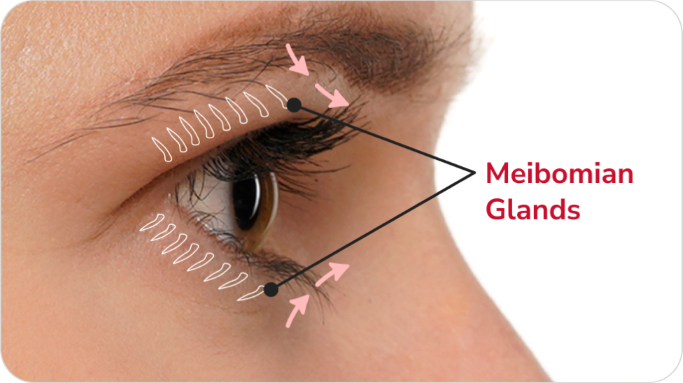Many Conditions Contribute to MGD
- Allergies
- Computer/device use
- Environment
- Eye surgery
- Glaucoma/chronic eye diseases
- Poor blinking
- Climate
- Contact lens wear
- Eye infections/styes9
- Gland-clogging makeup10
- Medications
- Reading/TV watching
Why drops are sometimes not enough for Dry Eye relief.

Your Meibomian glands produce the oily part of the tear film needed to protect the surface of your eye by preventing the evaporation of the watery part of your tears. When this function is not working well, your eyes may feel dry.
This is called Meibomian Gland Dysfunction, or MGD. MGD is a leading cause of Dry Eye, and can be the source of most dry eye symptoms, such as burning, stinging, and itching.
If ‘Yes , you may want to ask your doctor about Dry Eye and MGD.
Dryness, grittiness, and scratchiness in eyes
Burning and watery sensation in eyes?
Need for eye drops for short-term dry eye relief?
Interruption in daily activities
Tiredness in eyes
Frequent removal of contact lenes
Maintaining healthy function and structure of your Meibomian glands before you have dry eye symptoms is key, as MGD is a chronic, progressive, and obstructive condition.11-13 In fact, 20% of MGD patients may not have any dry eye symptoms.14
Understand how MGD may look like.
A Meibomian gland structure ranges anywhere from normal to significant gland loss, depending on whether or not the disease is present and the level of its severity. Your doctor may conduct additional tests, since imaging alone cannot diagnose MGD.
Meibomian glands secret lipids - the oily part of tears - which are a key component to the tear film that helps maintain a healthy ocular surface. When meibomian glands function correctly, these lipids reduce eye surface water evaporation.
When meibomian glands become blocked, the lipids cannot be released. The absence of lipids causes watery tears to dry up quickly, resulting in dry eye symptoms which can cause discomfort and sometimes blurry vision.
Left untreated, meibomian gland dysfunction progresses. Over time, the glands become completely obstructed, which then leads to meibomian gland atrophy, resulting in permanent changes in the tear film.
1. Lemp MA, Crews LA, Bron AJ, Foulks GN, Sullivan BD. Distribution of aqueous-deficient and evaporative dry eye in a clinic-based patient cohort: a retrospective study. Cornea. 2012 May;31(5):472-478.
2. Nichols KK, Foulks GN, Bron AJ, et al. The international workshop on meibomian gland dysfunction: executive summary. Invest Ophthalmol Vis Sci. 2011 Mar;52(4):1922-1929.
3. Machalinska A, Zakrzewska A, Adamek B, et al. Comparison of morphological and functional meibomian gland characteristics between daily contact lens wearers and nonwearers. Cornea. 2015 Sep;34(9):1098-1104.
4. Jin X, Lin Z, Liu Y, Lin L, Zhu B. Hormone replacement therapy benefits meibomian gland dysfunction in perimenopausal women. Medicine (Baltimore). 2016 Aug;95(31):e4268. doi: 10.1097/MD.0000000000004268. PMID: 27495030; PMCID: PMC4979784.
5. Shamsheer RP, Arunachalam C. A Clinical Study of Meibomian Gland Dysfunction in Patients with Diabetes. Middle East Afr J Ophthalmol. 2015 Oct-Dec;22(4):462-6. doi: 10.4103/0974-9233.167827. PMID: 26692718; PMCID: PMC4660533.
6. Uzunosmanoglu E, Mocan MC, Kocabeyoglu S, Karakaya J, Irkec M. Meibomian gland dysfunction in patients receiving long-term glaucoma medications. Cornea. 2016 Aug;35(8):1112-1116.
7. Cochener B, Cassan A, Omiel L. Prevalence of Meibomian Gland Dysfunction at the time of cataract surgery. J Cataract Refract Surg. 2018 Feb;44(2):144-148.
8. Brooks CC, Gupta PK. Meibomian gland morphology among patients presenting for refractive surgery evaluation. Clin Ophthalmol. 2021;15:315–21.
9. Duke University website. Immune response likely culprit in eyelid gland condition that causes dry eye. Found at: https://dukeeyecenter.duke.edu/news-events/immune-response-likely-culprit-eyelid-gland-condition-causes-dry-eye, July 2018. Accessed December 10, 2019.
10. American Optometric Association, Paraoptometric Resource Center, CPC Submission, T Petrosyan. Cosmetics and the eye: how your beauty products could be harming your eyes. Found at: https://www.wpa-eyes.org/wp-content/uploads/2018/11/Cosmetics-and-the-Eye.pdf, 2018. Accessed December 10, 2019.
11. Nichols KK, Hanlon SD, Nichols JJ. A murine model for characterizing glandular changes in obstructive meibomian gland dysfunction. ARVO. 2014. Abstract #13-A0002.
12. Schaumberg DA, Nichols JJ, Papas EB, Tong L, Uchino M, Nichols KK. The international workshop on meibomian gland dysfunction: report of the subcommittee on the epidemiology of, and associated risk factors for, MGD. Invest Ophthalmol Vis Sci. 2011 Mar;52(4):1994-2005.
13. Tomlinson A, et al. The International Workshop on Meibomian Gland Dysfunction: Report of the Diagnosis Subcommittee. Invest Ophthalmol Vis Sci. 2011;52(4):2006-49.
14. Viso E, et al. Prevalence of asymptomatic and symptomatic Meibomian Gland Dysfunction in the general population of Spain. Invest Ophthalmol Vis Sci. 2012; 53(6): 2601–2606. doi: 10.1167/ iovs.11-9228. 1992;19(12):1950-1954.
15. Internal Data on File, 2019.
2024PP10194